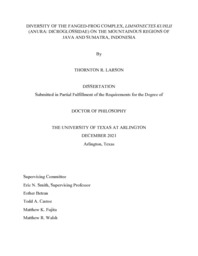
ATTENTION: The works hosted here are being migrated to a new repository that will consolidate resources, improve discoverability, and better show UTA's research impact on the global community. We will update authors as the migration progresses. Please see MavMatrix for more information.
Show simple item record
| dc.contributor.advisor | Smith, Eric N | |
| dc.creator | Larson, Thornton Robert | |
| dc.date.accessioned | 2023-06-28T15:16:36Z | |
| dc.date.available | 2023-06-28T15:16:36Z | |
| dc.date.created | 2021-12 | |
| dc.date.issued | 2021-12-21 | |
| dc.date.submitted | December 2021 | |
| dc.identifier.uri | http://hdl.handle.net/10106/31375 | |
| dc.description.abstract | The cryptic species complex, Limnonectes kuhlii, previously was considered to have a large range across Southeast Asia. Recent works have started to identify species within the complex using primarily genetic methodologies. The largest absence in elucidating these relationships comes down to sampling. Traditionally sampling across Southeast Asia has been challenging, limiting sampling across the entirety of a species range. Nowhere is this more apparent than in Indonesia. Indonesia has been highlighted as a biogeographical hotspot for species despite limited sampling on any of the main or smaller islands across the archipelago. Countries such as Malaysia and Papua New Guinea that share borders with Indonesia on certain islands have much more sampling across a wider diversity of habitats and some such as the northern part of Borneo are even cited as areas of high speciation. This study uses the most extensive sampling across the islands of Java and Sumatra in modern reconning and utilizes those to look at genetic relationships across the islands. Utilizing sanger sequencing for parts of the mitochondrial genome and ddRAD-seq to sequence across the nuclear genome strong separation is identified between the islands of Java and Sumatra. Also utilizing several species delimitation methodologies 23 or 24 species are identified in both islands, currently hidden under the moniker of Limnonectes kuhlii with six clades being identified on Java and 18 on Sumatra. This study also identified clear morphological and morphometric differences between the skulls of males and females of the Limnonectes kuhlii complex, highlighting overall head size as a clear difference between sexes. A study leading to a comparison between males of closely related species, and skull morphology being useful to identify differences in closely related species. Combined, all the methods used here, can assist in further identification of the species within the Limnonectes kuhlii complex on the islands of Java and Sumatra. | |
| dc.format.mimetype | application/pdf | |
| dc.language.iso | en_US | |
| dc.subject | Limnonectes kuhlii | |
| dc.subject | Biodiversity | |
| dc.subject | Indonesia | |
| dc.title | Diversity of the Fanged-Frog Complex, Limnonectes kuhlii (Anura: Dicroglossidae) on the Mountainous Regions of Java and Sumatra, Indonesia | |
| dc.type | Thesis | |
| dc.date.updated | 2023-06-28T15:16:37Z | |
| thesis.degree.department | Biology | |
| thesis.degree.grantor | The University of Texas at Arlington | |
| thesis.degree.level | Doctoral | |
| thesis.degree.name | Doctor of Philosophy in Quantative Biology | |
| dc.type.material | text | |
Files in this item
- Name:
- LARSON-DISSERTATION-2021.pdf
- Size:
- 6.481Mb
- Format:
- PDF
This item appears in the following Collection(s)
Show simple item record


